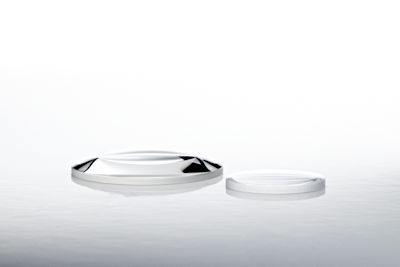Knight Optical puts Planoconvex Lenses in the spotlight
8th Jul 2021Here, Knight Optical – the leading supplier of custom-made and stock premium-quality optical components – uncovers all you need to know about Planoconvex Lenses.

Planoconvex Lenses for Laser-Based Communication Schemes
Of course, where optical components are involved, two worlds can often collide. For example, in another recent paper that employs Planoconvex Lenses, lasers and communication come together for an optical wireless communication system that uses air and water channels. Exploring the “alignment problem in wireless optical communication4“, the researchers included Planoconvex Lenses as part of their optical setup.
You can read a snippet about this study here.
What are Planoconvex Lenses?
As the name suggests, Planoconvex Lenses have one plane and one convex surface. With a positive focal length, their formation means they are ideally suited to applications that require focused, collected or collimated light. These lenses form a reasonable quality image close to the axis; however, chromatic aberration can often be an issue. As such, they can be, and are often, used as elements within more complex lens setups.
Here at Knight Optical, our Planoconvex Lenses are specified across a broad spectrum of industries for various applications – either as part of a multi-lens system or a standalone component.

What are Planoconvex Lenses Typically Used For?
Thanks to their ability to focus, collect and collimate light, Planoconvex Lenses are most commonly found within imaging systems, detectors and laser-based devices such as laser-cutting devices.

Planoconvex Lenses for Laser-Based Manufacturing Applications
Our custom-made Planoconvex Lenses are ideally suited to CO2 laser-cutting devices. These non-contact, gas-powered laser devices are peaking in popularity within manufacturing lines for tasks such as engraving and cutting objects and materials with high precision. Just a couple of the divisions that take advantage of these types of laser-based instruments include the automobile and textile industries.
Also within the manufacturing and industrial realm, Planoconvex Lenses have recently been employed for an experiment for a high-precision laser measurement system that focuses on straightness and parallelism1. Here, “a Planoconvex Lens was used to collimate a laser beam and concentrate the energy distribution of the diffraction effect1“.
Find out more about the experiment here.
Planoconvex Lenses for Communication Systems
Various forms of communication are constantly being investigated, and existing methods are continuously advancing across the world. When it comes to communication systems, optical components play a crucial role, and in the case of Planoconvex Lenses, there are copious sub-divisions that make use of their properties.
Visible Light Communication (VLC)
For example, in December 2020, Planoconvex Lenses were employed as part of a study for Visible light communication (VLC) – “a wireless optical communication technology that uses LEDs to send out high-speed light and dark flashing signals that are difficult to distinguish with the naked eye to transmit information2.” The experiment set out to explore how to make “the light intensity more uniform…via a compound eye lens combined with a sunflower planoconvex lens2“.
Click here to find out more about the experiment.
Free-Space Optics (FSO) Communication System
Another instance of using Planoconvex Lenses in communication systems is highlighted in a lens performance analysis for a free-space optics (FSO) communication system3. The study explores various lens configurations – comprising Biconvex and Planoconvex Lenses – to find the best method to “mitigate the fog scattering loss in a low-cost visible-band FSO communication system3“. After attempting various setups – including Biconvex-to-Biconvex, Planoconvex-to-Planoconvex and Biconvex-to-Planoconvex – the researchers discovered the double-lens “Biconvex-Planoconvex system performed 63.85% better than the Planoconvex-Planoconvex system and 50.42% better than the Biconvex-Biconvex system3“.
Click here to find out more about the study.

Planoconvex Lenses for Laser-Based Communication Schemes
Of course, where optical components are involved, two worlds can often collide. For example, in another recent paper that employs Planoconvex Lenses, lasers and communication come together for an optical wireless communication system that uses air and water channels. Exploring the “alignment problem in wireless optical communication4“, the researchers included Planoconvex Lenses as part of their optical setup.
You can read a snippet about this study here.

Knight Optical’s High-Quality, Metrology-Tested Planoconvex Lenses
Here at Knight Optical, our extensive range of Planoconvex Lenses are widely recognised for their premium quality. Typically, they are manufactured from BK7 (or equivalent), BaK4 (or equivalent) or sometimes SF11 (or equivalent) for lower spherical aberrations. As well as our stock Planoconvex Lenses, which are available from 2.5mm diameters up to 100mm in diameter in a full range of focal lengths with a range of AR-coated wavelength options, we also supply custom-made Planoconvex Lenses for seamless integration with end applications. Our custom options include uncoated or AR-coated Lenses for ultraviolet (UV), visible (VIS) and near-infrared (NIR) telecommunication wavelengths. Alternatively, we also offer a range of Infrared (IR) materials, such as Calcium Fluoride and Germanium.
Why Choose Knight Optical for your Application?
Discerning customers rely on Knight Optical not only for the premium quality of our output and in-house state-of-the-art Metrology Laboratory and QA Department‘s capabilities but because – as well as a range of Stock Optics (available for next-day dispatch) – we also offer our optics as Custom-Made Components.
This year, we’re celebrating 30 years in business. With three decades’ experience under our belt and a whole host of long-standing world-renowned customers on our books, we are proud to have worked on some of the most ground-breaking innovations.
If you are looking for premium-quality, bespoke optical components, please do not hesitate to get in touch with a member of the Technical Sales Team today.
FOOTNOTES
1https://metrology.wat.edu.pl/earlyaccess/28/3/MMS-01135-2020-04-Early-Access.pdf
2https://www.researchgate.net/publication/347640496_Design_and_Simulation_of_Compound_Eye_Lens_for_Visible_Light_Communication_and_Illumination
3https://www.spiedigitallibrary.org/conference-proceedings-of-spie/11678/116780V/Study-of-lens-performance-on-fog-mitigation-in-low-cost/10.1117/12.2583334.short?SSO=1
4https://www.sciencedirect.com/science/article/abs/pii/S003040182100328X